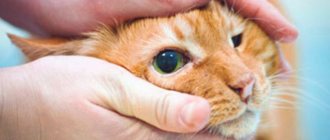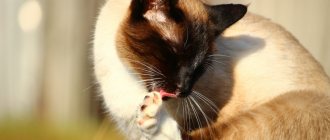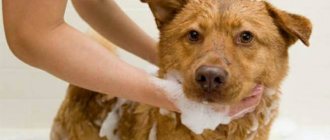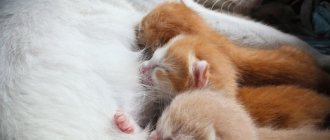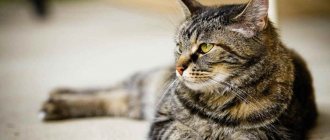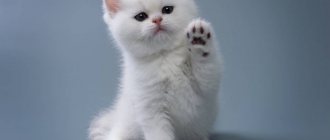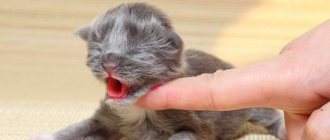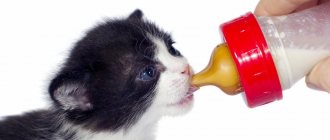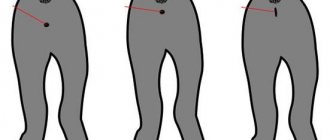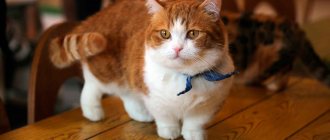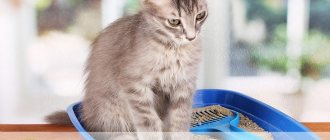Save the article:
The word “hernia” is familiar to many, but it does not always evoke associations with our smaller brothers, but a hernia in a cat
- a fairly common phenomenon. This term refers to various types of damage to muscles and some other tissues, in which protrusion or pinching of internal organs occurs. This may be a congenital defect of the body or resulting from a blow or muscle strain.
What is a hernia in cats and kittens?
This term refers to a disease that involves the loss of internal organs or parts thereof through natural or pathologically formed openings. In addition to neighboring cavities, they can fall out into the subcutaneous or intermuscular space.
Education itself always consists of 3 parts:
- hernial contents - an organ or part of it protruding through adjacent tissues;
- hernial sac - stretched tissue of the peritoneum or other cavity where the organ should be located;
- hernial orifices are openings through which an organ protrudes.
Lack of timely treatment is fraught with inflammation or strangulation of the protruding fragment. In both cases, it may suffer from necrosis and lose its functionality.
What kind of research is carried out at the RosVet EC?
Diagnostic measures necessarily include radiography. If there is no clear line of the diaphragm on the image, the veterinarian always suspects a diaphragmatic hernia. Visualization of the internal organs in the thoracic region, which anatomically should be located in the abdominal cavity, only confirms the diagnosis.
Contrast studies are necessary if there is pleural effusion. Peritoneography is performed to confirm rupture of the diaphragm; if there is damage, then the contrast agent will be in the chest cavity. Ultrasound is prescribed as an auxiliary study.
Causes of pathology
In kittens, pathology usually develops at the site of the umbilical ring due to the impossibility of its independent contraction. This is due to poor tissue regeneration, weak abdominal muscles and a non-standard shape of the navel.
In adulthood, the problem appears as a result of exposure to unfavorable factors:
- loss of muscle tone as a result of aging and inactivity;
- kidney disease, severe cough, flatulence, frequent constipation and vomiting;
- increased intra-abdominal pressure that increases during pregnancy;
- postoperative complications, cardiovascular pathologies and injuries.
Pathology is often inherited. For this reason, kittens born from sick parents must be neutered.
Read also:
How to relieve a cat's pain? What medications are dangerous for cats?
Urological syndrome in cats: what to do if your cat has problems with urination?
Kidney failure in cats: symptoms and treatment
Contributor Bio
Dr. Sarah Wooten
Dr. Sarah Wooten graduated from the UC Davis School of Veterinary Medicine in 2002. A member of the American Society of Veterinary Journalists, Dr. Wooten divides his professional time between his private small animal practice in Greeley, Colorado, public speaking on peer issues, leadership and client communication, and writing. She enjoys being outdoors with her family, skiing, scuba diving and participating in triathlons.
Symptoms and signs
Symptoms of a hernia in cats depend on its type and stage. These include:
- depressed state;
- rapid pulse;
- involuntary urination or its absence for a long time;
- increased temperature at rest;
- dyspnea;
- nausea and vomiting;
- sharp back pain;
- lameness and paralysis;
- blue mucous membranes and weight loss;
- aggression when touched.
Due to the variety of possible signs, the pathology is easily confused with other diseases. Only visible formations can be self-diagnosed, but errors are not excluded here either. A lump under the skin can be either a harmless lipoma or a malignant neoplasm, so the only right decision in such a situation is to contact a veterinarian.
Prevention of the disease
Preventive measures to prevent a hernia from occurring in a meowing pet are quite simple to implement. These include:
- Quick response to problems that arise regarding the process of digestion and bowel movements.
- Breeders of purebred cats should limit the number of matings and births of their pets.
- Owners living on the upper floors are not recommended to allow the animal to sleep on the windowsill or move freely along the ledge. Try not to open windows and balconies unnecessarily; although cats are dexterous representatives of the fauna, they often do not calculate their strength and fall down.
- Monitor your cat’s diet, enrich it with vitamins and microelements.
- Avoid excessively intense physical activity for your pet.
A hernia is a serious disease that can disable and kill an animal if the owner is inattentive to the health of his animal. A number of the above recommendations, as well as scheduled examinations with a veterinarian at least once a month, will help you avoid pathology.
Main varieties
Due to their acquisition, hernias are divided into congenital and acquired. The former are often inherited from parents, while the latter are formed against the background of trauma and other external factors.
There are other classifications. The most extensive of them takes into account the place of formation of the pathology. On this basis, 7 varieties are distinguished.
Inguinal
In cats, inguinal hernia is diagnosed more often than in cats. The prolapse of organs through the inguinal canal mainly occurs in the postpartum period. Another reason is improper bowel function, accompanied by frequent constipation and increased gas production.
Intervertebral
A rare species that occurs against the background of deterioration of the vertebral discs after reaching 12 years of age. The hernial sac is formed by protrusion of the spinal cord and its roots, so first of all, the cat’s coordination is impaired and acute pain occurs.
Umbilical
Umbilical hernia is most common in cats and kittens. In most cases it turns out to be congenital. Acquired hernias appear on the abdomen of kittens due to an improperly cut umbilical cord.
In the absence of pinching, the formation easily hides inside when pressed and sometimes completely disappears without outside help. The hernial contents in this type are represented by the omentum, intestines and other organs located near the umbilical ring.
Diaphragmatic or hiatal
It can be congenital or acquired as a result of mechanical damage to the abdomen and chest. It is characterized by the passage of the contents of the abdominal cavity beyond the diaphragm. The advanced form of this pathology is fraught with heart failure and pulmonary edema.
Perineal
Forms between the bladder and rectum. Despite its softness, it causes severe pain when palpated. With the perineal type, the uterus, prostate gland, part of the intestine or bladder prolapses into the hernial sac. The risk group includes neutered older cats.
Pericardial-peritoneal
Another rare congenital variety, which is a subtype of the diaphragmatic one. Has a direct effect on the heart and is characterized by high mortality from heart failure.
Scrotal hernia
It is even less common than intervertebral. It develops as a complication of an inguinal hernia, when internal organs prolapse into the scrotal cavity. Affects the bladder and requires mandatory surgical intervention.
What symptoms should alert the owner?
If the organs of the abdominal cavity are shifted through the hole into the chest cavity, then compression of the lungs inevitably occurs, and also the organs themselves, pinched in the diaphragmatic hernia, have their blood circulation disrupted.
The following signs should alert a cat owner:
- obvious breathing problems;
- a superficial, shallow sigh;
- the cat deliberately extends its neck and head to improve air passage.
The liver, stomach and intestines “stuck together” cease to function normally, which visually may look like signs of gastrointestinal disorders or liver failure.
Diagnosis at the veterinarian
To make a diagnosis, the veterinarian examines the mustachioed patient and palpates the formation. If an internal form of pathology is suspected, ultrasound, X-ray, MRI and endoscopy are used. With the help of these studies, it is possible to establish the exact cause and type of formation, as well as the presence of organ displacement and the nature of the contents of the hernial sac.
The general condition of the body is determined by the results of blood and urine tests. An ECG is also required before surgery.
What is the treatment based on?
The method of treatment depends on the type and stage of the pathology. In the initial stages, they are limited to taking medications and physiotherapy, and in case of complications and the impossibility of manual reduction, they resort to surgery.
Taking medications
The return of organs to the desired cavity is stimulated with locally irritating ointments. Additionally, the mustachioed patient is prescribed anti-inflammatory and analgesics that reduce the size of inflammation and pain.
Physiotherapy
The umbilical and inguinal varieties lend themselves well to manual reduction. After the return of the prolapsed organs, the discrepancy in the navel is fixed with a special plaster, a rigid plate or a coin. Several massage sessions of the hernial ring are also required.
When is surgery indicated?
Herniotomy, or surgical excision of a hernia of the ears, is resorted to in advanced cases and in the absence of effect from conservative therapy. The operation is performed under general anesthesia.
After opening the hernial sac with a scalpel, the surgeon sets the organs in place, cleans the cavities of pus and removes dead tissue. At the end of the procedure, he stitches the wound and treats it with an antiseptic.
IMPORTANT!
The operation is contraindicated for female kittens less than six months old and male kittens less than 1 month old.
Care and diet during recovery
On average, the recovery period after surgery takes 7-10 days. To protect the stitches from damage, a bandage or veterinary cone is put on the cat. Antiseptic treatment is not always prescribed, so first of all it is necessary to ensure that the wound is dry and clean. If bleeding and pus appear, as well as suture material divergence, veterinary attention will be required.
The residual effect of anesthesia is observed for about a day. Lack of appetite and pacing are completely normal at this stage, as the animal will suffer from nausea, dizziness and poor coordination. To avoid injury, the cat should be placed directly on the floor and temporarily put on a starvation diet.
IMPORTANT!
Avoid jumping onto play structures, cabinets, and other vertical surfaces until stitches are removed.
If an interest in food appears, the operated pet can be given low-fat chicken broth, slimy porridge, vegetable puree or another easily digestible dish. If a cat eats dry food, then it is better to replace the usual “crackers” with wet food before recovery.
Dangerous consequences
Removing a hernia from a pregnant cat is carried out with extreme caution. If it has formed on the abdomen, then it must be operated on before the second half of pregnancy. Otherwise, due to the pressure of the enlarged uterus, not only the kittens, but also the mother herself may die. Regardless of the outcome of the operation, the sick animal must be excluded from participation in matings.
Other dangerous consequences include:
- prolonged constipation and bouts of vomiting that occur when the intestines are strangulated;
- various inflammations, including acute sepsis;
- urinary dysfunction and renal failure characteristic of bladder damage;
- general intoxication of the body;
- local or extensive necrosis.
If several complications develop at once, the pet falls into a coma and dies. It is possible to avoid death only through timely diagnosis - that is, immediately after detecting the first alarming symptoms, take the cat to the veterinary clinic.
IMPORTANT!
Complications can also arise during the rehabilitation period, so be sure to follow the recommendations received from your doctor and monitor your pet’s condition.
Complication of untreated hernia
Failure to treat a hernia can result in pinching, which, in turn, disrupts the blood supply to the affected organ and can lead to its atrophy or rupture. Damage to the urinary tract or uterus in a female threatens intoxication of the body.
If pinched, a pet may die within a few hours or minutes from painful shock. Only urgent surgical intervention will save him.
